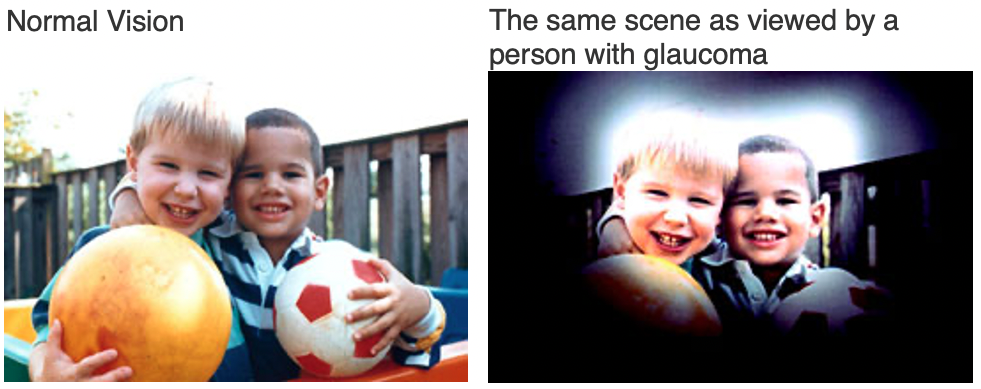January 2024 Newsletter
Have a Happy & Healthy New Year
What Do Christie Brinkley and Bono Have in Common?
Both supermodel Christie Brinkley and Bono, the lead singer of U2, were diagnosed with glaucoma during a routine eye exam. Both were also surprised by the diagnosis since they weren’t experiencing problems with their vision. That’s the sinister nature of glaucoma, one of the leading causes of blindness worldwide: People with glaucoma can lose most of their vision before they experience symptoms. Once vision is lost, it cannot be regained. That’s why the Eye Centers of Northwest Ohio and the American Academy of Ophthalmology is urging people to get regular eye screenings to protect their good vision.
Glaucoma is a group of diseases that damages the eye’s optic nerve. The optic nerve transmits visual information to the brain, allowing us to see. Because glaucoma often progresses slowly, affecting just peripheral or side vision, people with glaucoma can suffer significant vision loss before they notice a problem or a change in their vision. Central vision, the vision used to read, drive or watch TV, is usually unaffected until the disease is advanced.
The experience of both celebrities also serves as a reminder that glaucoma doesn’t have to mean blindness. If caught early, glaucoma can be treated with medicated eye drops or laser treatments.
The American Academy of Ophthalmology recommends all healthy adults get a comprehensive eye exam by age 40 to screen for blinding eye diseases. If eye disease runs in your family, you should see an eye doctor as soon as possible if you haven’t already.
Here’s who’s most at risk of a glaucoma diagnosis:
African Americans are 6 to 8 times more likely to get glaucoma than white Americans. Blindness from glaucoma is 6 to 8 times more common in African Americans than white Americans.
People with diabetes are 2 times more likely to get glaucoma than people without diabetes.
Hispanic Americans face an increased risk comparable to African Americans, but the disease may also progress faster as they age, compared with other ethnic groups.
Asians are at an increased risk for the less common types of glaucoma: angle-closure glaucoma and normal-tension glaucoma.
Also at risk are people over age 40, those who are severely nearsighted, and those who have a family history of glaucoma.
Here’s The Good News: Glaucoma Can Be Treated Successfully, If It’s Caught Early!
Appropriate treatment for glaucoma depends on the specific type and severity of the disease. Medicated eye drops or laser treatments are the most common initial approach. These techniques work by lowering eye pressure to reduce the amount of fluid in the eye, and by increasing fluid outflow from the eye.
Why Eye Doctors Don't Recommend Marijuana for Glaucoma
You might have heard from a dispensary or a friend that medical marijuana is an excellent treatment for glaucoma. But beware: It doesn't live up to the hype. Not only is marijuana a poor substitute for glaucoma medications, but CBD oil can actually worsen the condition.
The surest way to avoid vision loss from glaucoma is to follow your eye doctor’s prescribed treatments, whether that includes prescription eye drops or surgery.
Reason 1: Marijuana is not an effective glaucoma treatment
The evidence is clear: Prescription drugs can prevent glaucoma from stealing your sight. Marijuana cannot. When people with glaucoma use their medications correctly and undergo surgery if needed, they can almost always avoid going blind. Why take a risk with your vision?
Reason 2: Marijuana wears off too quickly to help glaucoma
While marijuana can lower pressure in the eye (elevated pressure contributes to glaucoma), this effect only lasts a few hours. Modern glaucoma medications last much longer.
Reason 3: You'd need to consume so much marijuana, you wouldn't be able to function
Because marijuana's effects are so short-lived, patients would need to take it continuously day and night to effectively treat glaucoma. Such sustained use would cause serious problems with memory, thinking and coordination. One study found that 9 of 9 patients could not tolerate the doses of marijuana necessary to treat glaucoma.
Driving under the influence is dangerous and illegal, and other daily activities such as cooking or even carrying on conversations would also become problematic. Is it really worth it?
Reason 4: Treating glaucoma with marijuana could raise the risk of blindness
Marijuana use can lower blood pressure, which slows blood flow to the optic nerve. This is a problem because the optic nerve connects the eye to the brain. Disrupting this connection could raise your risk of blindness.
Don’t Delay, Make An Eye Exam Part Of Your New Year’s Resolutions.
For more information:
www.eyecentersofnwo.com/adult-eye-disorders
For previous newsletters:
www.eyecentersofnwo.com/newsletters
January is Glaucoma Awareness Month
In This Issue
What Do Christie Brinkley and Bono Have in Common?
The Good News!
Why Eye Doctors Don't Recommend Marijuana for Glaucoma
Contact Us
2311 W. Hayes Ave
Fremont
Ohio 43420
(419) 334 8121
622 Parkway Drive
Fostoria
Ohio 44830
(419) 435 3482
Courtesy: Prevent Blindness
Courtesy: National Eye Institute, National Institutes of Health (NEI/NIH)
No Vision Insurance, No Problem. Join our Membership Program today!
Courtesy: The American Academy of Ophthalmology
For previous newsletters:
We Now Have Paperless Check-In Available
Follow the link that we text to you the day before your appointment










